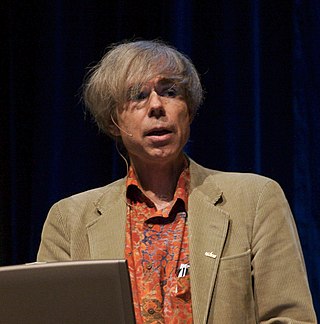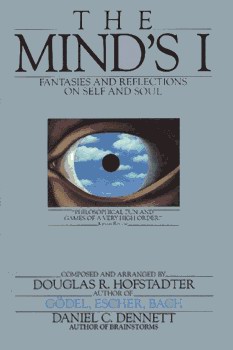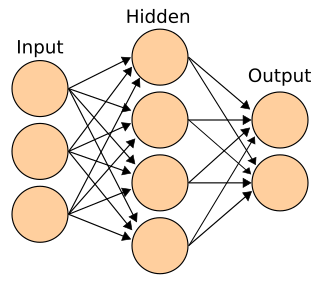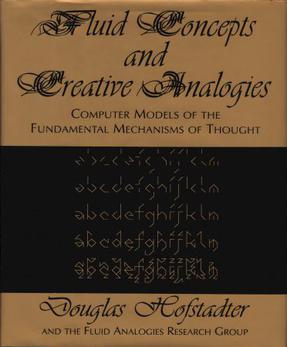Related Research Articles

Cognitive science is the interdisciplinary, scientific study of the mind and its processes with input from linguistics, psychology, neuroscience, philosophy, computer science/artificial intelligence, and anthropology. It examines the nature, the tasks, and the functions of cognition. Cognitive scientists study intelligence and behavior, with a focus on how nervous systems represent, process, and transform information. Mental faculties of concern to cognitive scientists include language, perception, memory, attention, reasoning, and emotion; to understand these faculties, cognitive scientists borrow from fields such as linguistics, psychology, artificial intelligence, philosophy, neuroscience, and anthropology. The typical analysis of cognitive science spans many levels of organization, from learning and decision to logic and planning; from neural circuitry to modular brain organization. One of the fundamental concepts of cognitive science is that "thinking can best be understood in terms of representational structures in the mind and computational procedures that operate on those structures."
The Chinese room argument holds that a digital computer executing a program cannot have a "mind," "understanding" or "consciousness," regardless of how intelligently or human-like the program may make the computer behave. The argument was presented by philosopher John Searle in his paper, "Minds, Brains, and Programs", published in Behavioral and Brain Sciences in 1980. Similar arguments were presented by Gottfried Leibniz (1714), Anatoly Dneprov (1961), Lawrence Davis (1974) and Ned Block (1978). Searle's version has been widely discussed in the years since. The centerpiece of Searle's argument is a thought experiment known as the Chinese room.

Douglas Richard Hofstadter is an American scholar of cognitive science, physics, and comparative literature whose research includes concepts such as the sense of self in relation to the external world, consciousness, analogy-making, artistic creation, literary translation, and discovery in mathematics and physics. His 1979 book Gödel, Escher, Bach: An Eternal Golden Braid won both the Pulitzer Prize for general nonfiction and a National Book Award for Science. His 2007 book I Am a Strange Loop won the Los Angeles Times Book Prize for Science and Technology.
Cognitive science is the scientific study either of mind or of intelligence . Practically every formal introduction to cognitive science stresses that it is a highly interdisciplinary research area in which psychology, neuroscience, linguistics, philosophy, computer science, anthropology, and biology are its principal specialized or applied branches. Therefore, we may distinguish cognitive studies of either human or animal brains, the mind and the brain.

The Mind's I: Fantasies and Reflections on Self and Soul is a 1981 collection of essays and other texts about the nature of the mind and the self, edited with commentary by philosophers Douglas R. Hofstadter and Daniel C. Dennett. The texts range from early philosophical and fictional musings on a subject that could seemingly only be examined in the realm of thought, to works from the twentieth century where the nature of the self became a viable topic for scientific study.

Connectionism refers to both an approach in the field of cognitive science that hopes to explain mental phenomena using artificial neural networks (ANN) and to a wide range of techniques and algorithms using ANNs in the context of artificial intelligence to build more intelligent machines. Connectionism presents a cognitive theory based on simultaneously occurring, distributed signal activity via connections that can be represented numerically, where learning occurs by modifying connection strengths based on experience.
Bio-inspired computing, short for biologically inspired computing, is a field of study which seeks to solve computer science problems using models of biology. It relates to connectionism, social behavior, and emergence. Within computer science, bio-inspired computing relates to artificial intelligence and machine learning. Bio-inspired computing is a major subset of natural computation.

Egbert B. Gebstadter is a fictional author who appears in the indexes of books by Douglas R. Hofstadter. For each Hofstadter book, there is a corresponding Gebstadter book. His name is derived from "GEB", the abbreviation for Hofstadter's first book Gödel, Escher, Bach: An Eternal Golden Braid; the letters appear in his last name, permuted in his first name, and permuted again in his initials.
Computational cognition is the study of the computational basis of learning and inference by mathematical modeling, computer simulation, and behavioral experiments. In psychology, it is an approach which develops computational models based on experimental results. It seeks to understand the basis behind the human method of processing of information. Early on computational cognitive scientists sought to bring back and create a scientific form of Brentano's psychology.

Mathematical psychology is an approach to psychological research that is based on mathematical modeling of perceptual, thought, cognitive and motor processes, and on the establishment of law-like rules that relate quantifiable stimulus characteristics with quantifiable behavior. The mathematical approach is used with the goal of deriving hypotheses that are more exact and thus yield stricter empirical validations. There are five major research areas in mathematical psychology: learning and memory, perception and psychophysics, choice and decision-making, language and thinking, and measurement and scaling.
Neurophilosophy or philosophy of neuroscience is the interdisciplinary study of neuroscience and philosophy that explores the relevance of neuroscientific studies to the arguments traditionally categorized as philosophy of mind. The philosophy of neuroscience attempts to clarify neuroscientific methods and results using the conceptual rigor and methods of philosophy of science.
Hybrid intelligent system denotes a software system which employs, in parallel, a combination of methods and techniques from artificial intelligence subfields, such as:
The philosophy of artificial intelligence is a branch of the philosophy of technology that explores artificial intelligence and its implications for knowledge and understanding of intelligence, ethics, consciousness, epistemology, and free will. Furthermore, the technology is concerned with the creation of artificial animals or artificial people so the discipline is of considerable interest to philosophers. These factors contributed to the emergence of the philosophy of artificial intelligence. Some scholars argue that the AI community's dismissal of philosophy is detrimental.

Stephen Malvern Omohundro is an American computer scientist whose areas of research include Hamiltonian physics, dynamical systems, programming languages, machine learning, machine vision, and the social implications of artificial intelligence. His current work uses rational economics to develop safe and beneficial intelligent technologies for better collaborative modeling, understanding, innovation, and decision making.

Fluid Concepts and Creative Analogies: Computer Models of the Fundamental Mechanisms of Thought is a 1995 book by Douglas Hofstadter and other members of the Fluid Analogies Research Group exploring the mechanisms of intelligence through computer modeling. It contends that the notions of analogy and fluidity are fundamental to explain how the human mind solves problems and to create computer programs that show intelligent behavior. It analyzes several computer programs that members of the group have created over the years to solve problems that require intelligence.

Computational creativity is a multidisciplinary endeavour that is located at the intersection of the fields of artificial intelligence, cognitive psychology, philosophy, and the arts.
Ron Sun is a cognitive scientist who made significant contributions to computational psychology and other areas of cognitive science and artificial intelligence. He is currently professor of cognitive sciences at Rensselaer Polytechnic Institute, and formerly the James C. Dowell Professor of Engineering and Professor of Computer Science at University of Missouri. He received his Ph.D. in 1992 from Brandeis University.
Mark Henry Johnson is a British cognitive neuroscientist who, since October 2017, has been Professor of Experimental Psychology and Head of the Department of Psychology at the University of Cambridge. He is a Fellow of the Association for Psychological Science.
The LIDA cognitive architecture is an integrated artificial cognitive system that attempts to model a broad spectrum of cognition in biological systems, from low-level perception/action to high-level reasoning. Developed primarily by Stan Franklin and colleagues at the University of Memphis, the LIDA architecture is empirically grounded in cognitive science and cognitive neuroscience. In addition to providing hypotheses to guide further research, the architecture can support control structures for software agents and robots. Providing plausible explanations for many cognitive processes, the LIDA conceptual model is also intended as a tool with which to think about how minds work.
Cognitive musicology is a branch of cognitive science concerned with computationally modeling musical knowledge with the goal of understanding both music and cognition.
References
- 1 2 Gödel Escher Bach : Les Brins d'une Guirlande Eternelle. ASIN 2100523066.
- ↑ Communications of the ACM, December 2012, vol. 55, no. 12, 74–77
- 1 2 3 4 5 6 7 8 9 10 11 12 13 "ROBERT M. FRENCH" (PDF). University of Burgundy.
- ↑ Tabletop: an emergent, stochastic computer model of analogy-making (intelligence modeling). OCLC WorldCat. OCLC 68794705.
- ↑ French, Robert Matthew (1995). The Subtlety of Sameness: A Theory and Computer Model of Analogy-making. ISBN 9780262061803.
- ↑ Markman, Arthur B. (1996). "Extended Book Review: The Subtlety of Sameness by Robert M. French". International Journal of Neural Systems. 07 (5): 665–670. doi:10.1142/S0129065796000737.
- ↑ "The subtlety of sameness a theory and computer model of analogy-making". Villanova University.
- ↑ "Moving Beyond the Turing Test" (PDF). Yildiz.
- ↑ "Artificial Intelligence Could Be on Brink of Passing Turing Test". Wired. 2012-04-12.
- ↑ "Computational Biology and "Dusting Off the Turing Test"". Computing Community Consortium. 15 April 2012.
- 1 2 French, R. M. (2000). "The Turing Test: The First Fifty Years". Trends in Cognitive Sciences. 4 (3): 115–122. doi:10.1016/S1364-6613(00)01453-4. PMID 10689346. S2CID 1930455.